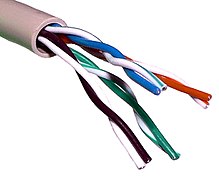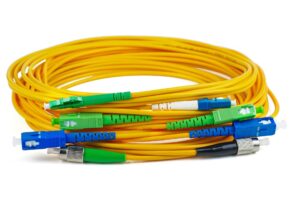Over the past few years, Ethernet has enhanced the provision of high-speed internet solutions. In order to satisfy the unending need for higher-speed internet, various Ethernet standards have emerged. Two prominent ones are Gigabit Ethernet and 10 Gigabit Ethernet. They offer different maximum transmission speeds.
In this post, we will explore the distinctions between these Ethernet standards and provide you with valuable insights that will help you discover which of them is convenient for your business; taking both cost and quality of service into consideration.
What is Gigabit Ethernet?
As we introduced in our article on 10/100 Ethernet vs. 1000 Ethernet, Gigabit Ethernet is an Ethernet standard that supports data transfer speeds of up to 1000 Mbps (1 Gbps).
Ethernet first started with the 10 Mbps standard, which was capable of transmitting at a maximum speed of 10 megabits per second. Later, 100 Ethernet surfaced before the development of Gigabit Ethernet, which is popular among enterprise businesses today.
Gigabit Ethernet was standardized by the IEEE in 1999, and It represents a significant advancement in network speeds and performance.
What is 10 Gigabit Ethernet?
After 1 Gigabit Ethernet, 10 Gigabit Ethernet is the next-generation Ethernet standard that supports data transfer rates of up to 10,000 Mbps. Industries that heavily rely on data-intensive tasks, such as large-scale data centers, cloud computing, and multimedia applications, greatly benefit from this Ethernet standard.
Gigabit Ethernet vs. 10 Gigabit Ethernet
To facilitate a better understanding of these Ethernet standards, let us compare them across various parameters:
| Parameter | Gigabit Ethernet | 10 Gigabit Ethernet |
|---|---|---|
| Cable Type | Copper and Fiber Optic | Copper and Fiber Optic |
| Speed | Up to 1000 Mbps | Up to 10,000 Mbps |
| Scalability | Limited | High |
| Coverage | Local Area Networks (LAN) | LAN and Metropolitan Area Networks (MAN) |
| Cost | Cost-effective | Higher cost |
1. Cable Type
Gigabit Ethernet and 10 Gigabit Ethernet both support connectivity via copper and fiber optic cables. The choice of cable type depends on factors such as distance, budget, and desired transmission speed.


Copper cable Fiber optic cable
Copper cables are generally more affordable, making them a popular choice for shorter distances, while fiber optic cables offer greater bandwidth and longer reach, making them suitable for long-distance connections.
2. Speed
Gigabit Ethernet provides data transfer speeds of up to 1000 Mbps, while 10 Gigabit Ethernet takes it a step further with speeds of up to 10,000 Mbps. This significant speed advantage of 10 Gigabit Ethernet makes it ideal for bandwidth-intensive applications that require lightning-fast data transmission.
3. Scalability
When it comes to scalability, 10 Gigabit Ethernet surpasses Gigabit Ethernet. The higher bandwidth capacity of 10 Gigabit Ethernet allows for future-proofing and accommodates increased network demands. This scalability advantage makes it a suitable choice for growing businesses and organizations planning to expand their network infrastructure.
4.Coverage
Gigabit Ethernet is primarily designed for Local Area Networks (LAN)
On the other hand, 10 Gigabit Ethernet extends its coverage to Metropolitan Area Networks (MAN), encompassing larger areas like cities or towns.
If your business operates across multiple locations or requires broader coverage, 10 Gigabit Ethernet can provide the necessary connectivity.
5. Cost
Gigabit Ethernet is generally considered a cost-effective solution. The hardware required for its implementation is readily available and affordable, making it an attractive option for businesses with budget constraints.
On the other hand, 10 Gigabit Ethernet tends to have a higher upfront cost due to the need for specialized equipment capable of handling the increased data transfer rates. However, it is essential to consider long-term benefits and potential cost savings that can result from 10 Gigabit Ethernet’s superior performance and scalability.
6. Power Consumption
Assess the power requirements and energy efficiency of your network infrastructure. Generally, 10 Gigabit Ethernet equipment consumes more power than Gigabit Ethernet devices, which may impact your overall power budget and operating costs.
Gigabit Ethernet vs. 10 Gigabit Ethernet: FAQ
What is the advantage of 10 Gigabit Ethernet?
With its faster internet speeds, higher scalability, and enhanced performance, 10 Gigabit Ethernet enables efficient handling of data-intensive tasks. It reduces latency, facilitates smooth data transfers, and supports advanced technologies such as virtualization and cloud computing.
10 Gigabit Ethernet is a suitable choice for businesses that rely on demanding applications and require exceptional network performance.
Is 1 Gigabit Ethernet Fast?
Yes, Gigabit Ethernet is considered a fast internet solution, providing data transfer speeds of up to 1000 Mbps. Compared to previous Ethernet standards, Gigabit Ethernet offers a significant improvement in network speed and performance. It is suitable for most businesses and individuals seeking reliable and speedy network connections.
What is difference between 1g Ethernet & 10G Ethernet?
The primary difference between 1 Gigabit Ethernet and 10 Gigabit Ethernet lies in their maximum data transfer speeds. While 1 Gigabit Ethernet offers speeds of up to 1000 Mbps, 10 Gigabit Ethernet achieves speeds of up to 10,000 Mbps. This greate increase in speed positions 10 Gigabit Ethernet as the ultimate choice for high-bandwidth applications and large-scale networks requiring exceptional performance.
Is 10Gb faster than 1Gb?
Yes, 10 Gigabit Ethernet is faster than 1 Gigabit Ethernet. With its maximum data transfer speed of 10,000 Mbps, 10 Gigabit Ethernet outpaces 1 Gigabit Ethernet by a significant margin. The enhanced speed and performance of 10 Gigabit Ethernet make it highly desirable for businesses that demand cutting-edge network capabilities.
Is 1gb Ethernet good for gaming?
For most gaming purposes, 1 Gigabit Ethernet provides ample speed and reliability. It offers fast and stable connections, ensuring a smooth gaming experience. However, in scenarios involving heavy multiplayer gaming, streaming, or data-intensive online gaming, 10 Gigabit Ethernet may provide additional benefits by delivering faster and more responsive network performance.
What is the fastest Ethernet speed?
The fastest Ethernet speed currently available is 100 Gigabit Ethernet (100 GbE). It supports data speeds of up to 100 billion bits per second (Gbps), which is ten times faster than 10 Gigabit Ethernet (10 GbE).
Can I upgrade from Gigabit Ethernet to 10 Gigabit Ethernet?
Yes, but it may require compatible network infrastructure, including switches, routers, and network interface cards, supporting 10 Gigabit Ethernet.
What types of cables are used for Gigabit Ethernet & 10 Gigabit Ethernet?
Both Gigabit Ethernet and 10 Gigabit Ethernet can use copper cables (e.g., Cat 5e or Cat 6) for shorter distances, but 10 Gigabit Ethernet often relies on fiber optic cables for longer distances.
What are the applications for Gigabit Ethernet & 10 Gigabit Ethernet?
Gigabit Ethernet is commonly used in home networks, small businesses, and some enterprise environments. 10 Gigabit Ethernet is typically deployed in data centers, high-performance computing, and enterprise networks with heavy bandwidth requirements.
What are the maximum cable lengths for Gigabit Ethernet & 10 Gigabit Ethernet?
The maximum cable length for Gigabit Ethernet using copper cables, such as Cat 5e or Cat 6, is 100 meters (328 feet). However, the maximum length for 10 Gigabit Ethernet over copper cables is typically limited to 55 meters (180 feet) due to the higher bandwidth requirements and signal degradation.
For longer distances, 10 Gigabit Ethernet often relies on fiber optic cables, which can support distances of up to 300 meters (984 feet) or more, depending on the cable type and quality.
Can I mix Gigabit Ethernet & 10 Gigabit Ethernet devices within the same network?
Yes, it is possible to mix Gigabit Ethernet and 10 Gigabit Ethernet devices within the same network. However, it requires appropriate network infrastructure and compatible equipment to ensure seamless connectivity and data transfer.
Conclusion
When choosing an Ethernet standard for your business or personal network solution, it is important you consider your specific needs, budget, and future growth plans.
Gigabit Ethernet and 10 Gigabit Ethernet each offer distinct advantages. Gigabit Ethernet provides a cost-effective and reliable solution suitable for most businesses, while 10 Gigabit Ethernet delivers unparalleled speed, scalability, and performance, catering to bandwidth-intensive applications and larger networks.
With some of the factors with covered in this post, we trust that you can make an informed decision and select the optimal Ethernet standard to meet your network infrastructure requirements.

I am a passionate Networking Associate specializing in Telecommunications.
With a degree in Electronic engineering, I possess a strong understanding of electronic systems and the intricacies of telecommunications networks. I gained practical experience and valuable insights working for a prominent telecommunications company.
Additionally, I hold certifications in networking, which have solidified my expertise in network architecture, protocols, and optimization.
Through my writing skills, I aim to provide accurate and valuable knowledge in the networking field.
Connect with me on social media using the links below for more insights.
You can contact me using [email protected] or connect with me using any of the social media account linked below



